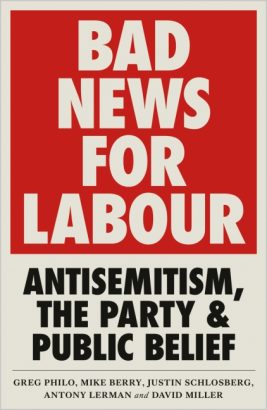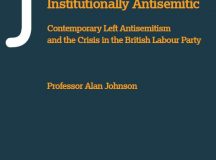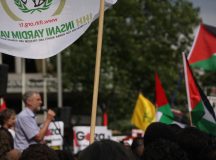This review first appeared in the British socialist newspaper Solidarity.
In February of this year, Chris Williamson, Labour MP for Derby North, complained about the Labour Party’s response to criticisms of antisemitism: ‘I’ve got to say I think our party’s response has been partly responsible for that because in my opinion we’ve backed off far too much, we’ve given too much ground, we’ve been too apologetic. What have we got to apologise for? ‘ Bad News for Labour – Antisemitism, The Party and Public Belief is the literary version of Williamson’s claim.
Less rabble-rousing and less rhetorical. More nuanced and more refined. Sometimes even making valid points. But, in essence, after Williamson the speech we now have Williamson the book.
Chapter one summarises findings from surveys and focus groups. These show that the proportion of Labour Party members perceived to be subject to allegations of antisemitism is far greater (25 per cent to 40 per cent) than the real figure (0.1 per cent). This misperception is attributed to saturation coverage of Labour and antisemitism in the media. The chapter concludes with outlining the ‘essential principles’ of an effective media strategy which Labour should adopt.
Chapter two provides an explanation for ‘this crisis’, defined as being one of ‘an extraordinary public relations disaster’. The Labour leadership was ‘navigating through a complex series of conflicts (between) different groups and factional interests’. It was these conflicts which ‘made the development of a unified position within the Party close to impossible.’
Chapter three appears to continue the theme of media management: ‘The problem facing the leadership was to develop a coherent plan of action … There was a lack of focus and unified effort in organising public relations … The leadership did not have the strong public relations infrastructure which was needed.’ In fact, the chapter quickly heads off in a variety of different directions: How many Party members were subject to allegations of antisemitism; the ‘very fraught ‘ relation between Corbyn’s team and full-time staff; Jon Lansman; an article by Alan Johnson (editor of Fathom); BDS; more attacks on Corbyn by Labour MPs; Zionism; Israel; the April 2019 Israeli elections …
The focus of chapter four is media misreporting of the 2018 arguments about the Labour Party’s adoption of the International Holocaust Remembrance Alliance (IHRA) definition and examples of antisemitism. It highlights the lack of balance in media coverage, the different interview techniques to which supporters and opponents of the definition were exposed, and straightforward inaccuracies in the coverage.
Chapter five – the book’s longest chapter, based on three articles previously published by openDemocracy – is a critique of the IHRA definition, and a pre-emptive critique of the current investigation of the Labour Party by the Equality and Human Rights Commission. A modest chapter six (just seven pages) is an account of an academic wrongly accused of antisemitism on the basis of the IHRA definition and examples of antisemitism.
There then follows a conclusion, a Timeline of Events (with no explanation of the basis on which events have been included or excluded), and a Bibliography.
Absent from the Bibliography are works such as Colin Shindler’s ‘Israel and the European Left’, Dave Rich’s ‘The Left’s Jewish Problem’, Dave Hirsh’s ‘Contemporary Left Antisemitism’, and Bob Fine and Phil Spencer’s ‘Antisemitism and the Left: The Return of the Jewish Question.’ This absence reflects something more fundamental about the book as a whole. It treats the problem of antisemitism in the Labour Party as essentially as one of numbers: How many antisemites are there in the Party? Answer: Just 0.1 per cent. Conclusion: It’s really all media hype, in collusion with right-wing Labour MPs and the Israeli government. Momentum founder Jon Lansman is singled out for criticism for even questioning the talismanic figure of 0.1 per cent. Lansman’s statements that antisemitism in the Party is ‘more widespread’ than previously thought and is ‘polluting the atmosphere in a lot of constituency parties and online’ are dismissed because ‘no figures were offered … again, no alternative evidence is given.’
Virtually ignored are the arguments by Rich, Hirsh and many others that the problem of antisemitism manifests itself today primarily in the incorporation of antisemitic ways of thinking (the great hidden power of Jews, the uniquely evil nature of Jewish nationalism, etc.) into attitudes to Israel and Zionism – that people can fall into antisemitism while sincerely considering themselves not hostile to Jews as Jews.
Insofar as such arguments are touched upon in passing, it is only for the purpose of derision: ‘The suggestion of a bias which is unknown, unrecognised and widespread means that intrinsically it cannot be quantified. Party members might be forgiven for asking what special power anyone has to identify what is going on in their minds when they don’t know it themselves. ‘
The book variously refers to ‘new antisemitism’, the ‘notion of the “new anti-Semitism”’, ‘the notion or theory of the “new anti-Semitism”‘ – the use of inverted commas indicates a rejection of the concept itself – and portrays it as a tool of the Israeli government: ‘Promoting the notion of the “new anti-Semitism” became a core strategic task of (the Israeli) government. And the IHRA definition has become a key weapon in that effort … The Israeli government needs the “new anti-Semitism” to justify its actions.’ Academic Avi Shlaim is quoted uncritically in support of the same argument: ‘The crisis in the Labour Party was not primarily about antisemitism. The crisis was manufactured to serve the ends of a right-wing faction within the Labour Party as well as those of the Israel lobby.’
But what the authors call the ‘new antisemitism’ is hardly new. Steve Cohen highlighted the problem of a new antisemitism on the left in That’s Funny – You Don’t Look Antisemitic, published as long ago as 1984. At least no-one ever accused Steve Cohen of being an Israeli government stooge.
On only one occasion does the book directly address the argument that contemporary antisemitism manifests itself primarily in the language of anti-Zionism and conceptualisations of Israel. The argument is cursorily dismissed: ‘If a statement … is based on a view of Jewish people in general, then that would clearly be antisemitic. But if the statement relates to an appraisal of actual events, then it would either be correct or not, without any racist implications.‘ But this would rule out the possibility that ‘an appraisal of actual events ‘ could be incorrect precisely because it is underpinned, coloured or defined by antisemitic assumptions – and therefore does have ‘racist implications’.
Much of the scandal-mongering media coverage of the Labour Party and antisemitism which the book highlights is targeted at Corbyn. But while half of the book is given over to critiquing the IHRA antisemitism definition, there is no analysis of Corbyn’s own politics and statements on issues relating to antisemitism, Zionism and Israel. There is passing reference to Corbyn’s defence of the Mear One antisemitic mural and his description of members of Hamas and Hezbollah as ‘friends’. But the problem identified by the book is not what this says about Corbyn’s own politics. The problem is defined as the criticism generated: ‘Corbyn’s authority was also weakened by attacks on his own history.’ In passing – everything in the book about Corbyn is in passing – the book refers to ‘a constant stream of attacks on Jeremy Corbyn for allegedly associating with antisemites.’ There is no consideration of whether such criticisms are accurate. Instead they are portrayed as a means to pressurise the Labour Party into adopting the IHRA definition: The attacks ‘now paid off’ and the Labour Party NEC adopted the IHRA definition and examples.
Corbyn’s involvement in the PLO wreath-laying ceremony of 2014 also gets a mention – but only for the purpose of emphasising that ‘Corbyn had a long anti-racist record and had in fact apologised in August 2018 for the hurt that has been caused to many Jewish people.’ Corbyn’s 2012 interview with Iranian Press TV in which he accused Israel of involvement in the murder of 16 Egyptian policemen is mentioned – in the small print of the book’s Timeline and without analysis of the underpinning politics. Likewise Corbyn’s comments at a meeting in Parliament in 2013 about Zionists not understanding English irony despite the length of time they had lived in the country: again, in the small print of the book’s Timeline and with no analysis.
In place of an analysis of Corbyn’s politics, the book counters charges of antisemitism by invoking homilies about Corbyn’s ‘long anti-racist record’, ‘lifetime of antiracism’ and the absence of ‘a racist or antisemitic bone in Jeremy’s body.’ But in a book which uncritically quotes the Swawkbox website as if it were a reliable source of information and commentary on Labour-internal events (p. 67), anything is possible.
The book seems to present itself as an analysis of media misreporting of the issue of the Labour Party and antisemitism. In fact it contains its own version of the Israel/Palestine conflict, even if only in the form of scattered assertions presented as uncontested statements of fact. The creation of the state of Israel was ‘a settler colonial project’ (rather than primarily a coming-together of refugees). It ‘resembled in many ways’ settler colonies in the North of Ireland, Algeria and South Africa. Left critics of Israel argue that Israel is ‘essentially a settler colonial state.’ BDS rather than building closer links with peace groups in Israel is the way forward: ‘Of course, peace in even small fringe groups is laudable, but we are still left with the issue of what is going to alter the approach of the Israeli state.’ It is not just peace groups which are irrelevant. Given the results of the April 2019 Israeli elections, virtually the entire population of Israel can be written off: ‘Israelis now firmly believe that the status quo is the solution to the conflict … Israel today is exactly what most of its citizens want. For the overwhelming majority of voters, the ultimate peace solution is one whereby the country has to sacrifice nothing to gain everything.‘
This argument does at least have a pedigree. Socialist Worker provided the same analysis of the Israeli elections – in 1996: ‘The Israeli election has shattered the myth of Israel as a united Jewish nation which wants peace with its Palestinian and Arab neighbours.’ (SW, 1497) And an independent Palestine alongside of Israel has long been impossible: ‘Tel Aviv used the Oslo peace accords … to destroy any prospect for an equitable two-state solution.’ The two-state solution is ‘dead in the water.’
In the spirit of Chris Williamson, the book laments the readiness of the Labour Party and Labour MPs to make apologies. Thus, the book’s conclusion criticises the Party leadership for failing to defend Labour MP Richard Burgon for having said that ‘the enemy of the Palestinian people are Zionists and Zionism is the enemy of peace and the enemy of the Palestinian people’: ‘It should not have been left to Geoffrey Bindman and Stephen Sedley to write to the Guardian pointing out that Burgon had no need to apologise.’
The book has garnered statements of support from Ken Loach and Noam Chomsky. Once Tony Greenstein, Chris Williamson, Jackie Walker and Pete Gregson have had a chance to read it, its authors will have a full set.




































https://onthedarkside410122300.wordpress.com/2019/09/24/bad-news-for-ken-loach-youve-got-the-wrong-book/
My review is here.
Crooke misses the point. The one piece of new analysis in the book is bogus because Philo and Berry take the average instead of the mode.
They say their poll implies that on average people believe that 34% of Labour members have been accused of antisemitism.
No it doesn’t. The mode of the survey says that the most common belief is that around 5% of Labour members have been accused of antisemitism.
The rest of the book is repetition of bogus material already published.